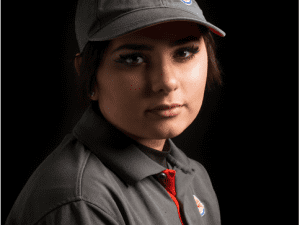Hussina Raja is a British Kashmiri artist, filmmaker and actress. Using film, photography, installation, archive footage and performance, her practice is rooted in social justice. Her work navigates social constructs of reality by focusing on bicultural identity, migration and belonging. ROOTS questions what it means to be British, surveying experiences of immigrants who have adapted their identities to fit in with cultural norms of a new society. The film reflects Raja’s life as a second generation South-Asian Brit. It considers the process that migrants go through to be accepted, and questions at what stage an immigrant becomes fully integrated. In this interview, Raja tells us more about the significance of hair in the film, her considerations when it came to selecting the music and her current work in Tower Hamlets.

A: There are key scenes where we see hands cutting and changing the hair of the principle characters. Could you tell us more about these moments?
HR: Hair is political. It says so much about us as people, about our heritage and our history. The cutting of hair is the removing of what makes us who we are, it represents our individuality and our differences – our “foreignness.” It is the literal shedding and stripping of one’s identity in order to assimilate, to conform and be moulded into an aesthetic that is palatable and acceptable for the majority. The act of enduring this is a comment on obedience, control and the power dynamics at play.
A: How did you select the music to accompany the film?
HR: I worked with the talented composer and musician that is Sarathy Korwar, who created an original sound that rhythmically responded to the beats and shifts of the characters’ internal and external journeys. I wanted a sound that reflected and was synonymous with the South Asian subcontinent, something that evoked a visceral response in me. If you closed your eyes and just listened to the music, I wanted the pace to be able to translate the characters’ experiences.
A: What do you want audiences to take away from this piece?
HR: I’m interested in what audiences feel whilst watching ROOTS, how they connect and relate to this piece of work. I enjoy listening to people’ interpretations and understanding of the film. I want audiences to leave thinking about their personal response to the work.
A: How do you feel about being a part of the Aesthetica Art Prize shortlist?
HR: It’s a great feeling to have my work appreciated and recognised alongside a group of amazing artists. My journey into the arts has been very instinctual and DIY without any formal training, so to be shortlisted for the Aesthetica Art Prize is a real sense of achievement for me and an honour. It’s something I’m proud to be apart of. I’m also excited to be sharing my work in Yorkshire and taking it to different audiences.

A: Could you tell us about any upcoming projects we can look forward to?
HR: I’m currently working on an interactive mixed media installation in Tower Hamlets in East London which addresses the politics of climate change through the existing food system. It’s a culmination and interpretation of a body of community research carried out in the borough over the last 3 years, that reflects on how food impacts local communities, and the importance of community organising in addressing climate issues. I’m also developing a piece of work that examines police power as well as my first narrative short film, which is a coming-of-age story about friendship.
Raja will feature in the Aesthetica Art Prize 2024 Exhibition at York Art Gallery from 16 February – 21 April. Meet over 250 longlisted international artists in our new online gallery.
Want to get involved? The next edition of the Prize is open for entries. Submit your work by 31 August. Win £10,000, exhibition and publication. Find out more here.
Image Credits:
- Hussina Raja. Stills from ROOTS (2020). Single channel digital video, 3 min 46 sec.





